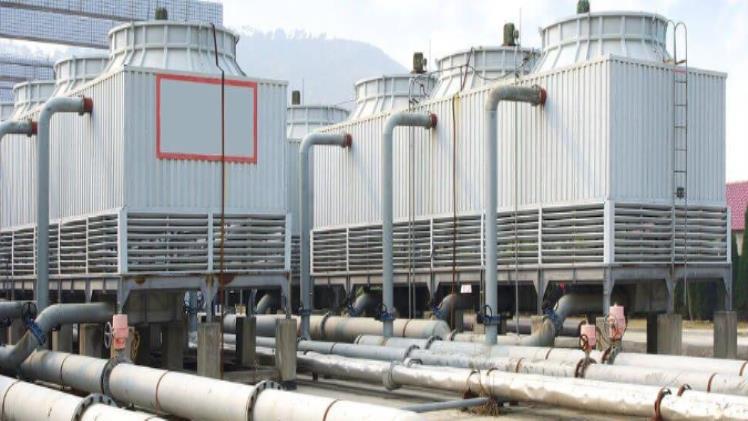A Comprehensive Guide to Choosing and Buying Cooling Towers

In industrial and construction projects, temperature control and heat management are among the most critical matters. Cooling towers enhance efficiency and reduce energy costs of cooling systems. Selecting the right cooling tower requires a clear understanding of its various types, technical specifications, and climate conditions, so that the optimal solution can be chosen according to the specific needs of the project. In this article, you will comprehend the types of cooling towers and the essential criteria for selecting and buying.
What is the Function of a Cooling Tower?
In large buildings and industrial projects, a cooling tower is a vital HVAC system. Its primary function is to reduce the temperature of circulating water. By transferring heat from water to the surrounding air, the cooling tower lowers the water temperature and returns it to the system cycle. Cooling towers are widely used in industrial projects, like power plants, refineries, and steel industries, as well as in large building projects like commercial and residential complexes.
Types of Cooling Towers and Their Features
Cooling towers can be categorized based on different factors, the most important being application, circuit type, body material, and geometric structure. Understanding these categories helps in selecting and buying a cooling tower that matches the project’s requirements.
Types of Cooling Towers by Application
Cooling towers are generally classified into two main categories based on application: “Industrial” and “HVAC.” Below is a detailed comparison of these two types.
Industrial Cooling Towers
Industrial cooling towers are used in large-scale industries such as power plants, refineries, petrochemical plants, and steel manufacturing. These types of cooling towers have very high capacities and can dissipate large amounts of heat efficiently.
HVAC Cooling Towers
HVAC cooling towers are mainly employed in building projects such as residential complexes, office buildings, hotels, hospitals, etc. Although their capacity is lower than that of industrial towers, they are fully capable of meeting the cooling requirements of buildings.
Types of Cooling Towers by Circuit
Cooling towers can also be classified by circuit type into three groups: open-circuit, closed-circuit, and hybrid towers, which combine features of both open and closed circuit types.
Open-Circuit Cooling Towers
In an open-circuit cooling tower, warm water comes into direct contact with ambient air, and part of it evaporates. Open-circuit towers generally have a lower initial cost and are easier to install and maintain, but they consume more water and are more prone to scaling.
Closed-Circuit Cooling Towers
Closed-circuit cooling towers utilize coil tubes for water circulation, and the air cools the water without direct contact. Water consumption in closed-circuit towers is much lower than in open-circuit towers, making them suitable for areas with limited water resources.
Hybrid Cooling Towers
Hybrid cooling towers combine both open and closed-circuit designs. Under normal conditions, the tower operates as a closed-circuit system, and when higher efficiency is required, it can function like an open-circuit tower. This design optimizes water usage and performs very well in regions with variable climates.
Types of Cooling Towers by Body Material
Cooling towers are generally classified into three main categories based on the body material: fiberglass, galvanized steel, and concrete. Each type has distinct characteristics that make it suitable for different applications.
Fiberglass Cooling Towers
Fiberglass cooling towers are the most frequently used type due to their high resistance to corrosion, lightweight structure, and long lifespan. Fiberglass requires less maintenance and performs excellently in humid environments.
Galvanized (Metal) Cooling Towers
Metal cooling towers are made from galvanized or steel sheets. They offer high mechanical strength. Galvanized cooling towers are mostly used in industrial projects. However, compared to fiberglass models, metal towers are more susceptible to corrosion and require more careful maintenance.
Concrete Cooling Towers
Concrete cooling towers are typically employed in very high-capacity industrial projects. Due to their robust structure and high resistance to harsh environmental conditions, they have a longer lifespan compared to fiberglass or galvanized types. Since building a concrete cooling tower is time-consuming and costly, these towers are primarily used in power plants, refineries, and heavy industries.
Types of Cooling Towers by Geometric Shape
Understanding cooling towers based on the geometric shape may seem simple at first glance, but it is actually one of the most critical considerations before you buy cooling towers. The main shapes are circular, cubic, and cross-flow designs.
Circular (Round) Cooling Towers
Round cooling towers feature a circular design that ensures uniform water and air distribution, offering high efficiency. They operate quietly and provide stable performance. The main drawback is that they require more installation space compared to cubic towers.
Cubic Cooling Towers
Cubic towers have a rectangular design that occupies less space, allowing for multiple towers to be installed side by side. Therefore, if your project requires multiple cooling towers and space is limited, cubic towers are a better choice than circular ones.
Cross-Flow Cooling Towers
In cross-flow designs, water moves vertically while air flows horizontally. This reduces pressure drop and allows quieter operation. Although efficiency may be slightly lower than round or cubic models under certain conditions, cross-flow towers are preferable in noise-sensitive environments.
Key Criteria for Selecting and Purchasing a Cooling Tower
To select a suitable cooling tower, several key factors must be kept in mind. The most important criteria include cooling capacity, local climate conditions, water quality, available installation space, and more.
Cooling Capacity of the Tower
One of the most critical factors is the cooling capacity of the tower, usually expressed in tons of refrigeration or kilocalories per hour. This capacity must match the system’s heat load. Choosing a tower with insufficient capacity leads to a lack of adequate reduction in the water temperature. Conversely, oversizing the tower results in higher initial costs and more occupied space. Hence, accurate capacity calculation by a qualified specialist is necessary.
Climate Conditions of the Installation Site
In hot and dry regions, open-circuit cooling towers are more efficient because water evaporation occurs more effectively. Conversely, in climates with high humidity or heavy air pollution, closed-circuit towers perform better since the water is not directly exposed to contaminants.
The Quality of Water Used by Cooling Tower
If the water contains high levels of hardness or dissolved minerals, the likelihood of scaling and clogging in open-circuit towers increases. In such cases, either closed-circuit towers should be used, or water treatment and softening systems should be installed alongside the tower. This consideration is essential in industrial projects with high water circulation volumes.
Cooling Tower Installation Space
Cubic towers are more suitable for locations with limited space, as multiple units can be installed side by side. In contrast, round towers require more space but benefit from more uniform air distribution. In addition to horizontal space, the tower height should also be compatible with environmental conditions and structural limitations.
Cooling Tower Price
The price of a cooling tower depends on several factors, including type, capacity, material, auxiliary equipment, and the manufacturer’s brand. Fiberglass towers generally fall into a mid-range price category, while closed-circuit and hybrid towers tend to be more expensive.
Additional Tips for Purchasing a Cooling Tower
What you have read so far covers the most important factors to consider before ordering or purchasing a cooling tower. Here are additional tips to guide your selection:
- Always choose a reputable brand and manufacturer to ensure the quality of materials and the tower’s efficiency.
- Pay attention to energy consumption and thermal performance. Energy-efficient towers reduce long-term project costs.
- If the cooling tower will operate alongside equipment such as air handling units (AHUs) or water-cooled chillers, ensure its capacity and type are compatible to maintain overall system efficiency.
- Consider auxiliary systems such as low-noise fans, variable-speed drives, and high-quality packings.
Finally, before buying, obtain price quotations from several reputable suppliers, such as DematTajhiz, and compare warranty and service terms.
About DematTajhiz HVAC Specialized Company
Since 2004, under the management of Engineer Majid Zovvarian, DematTajhiz HVAC Specialized Company has been a reliable source for purchasing various HVAC and building facility equipment, including cooling towers, air handling units, ducted split systems, fan coil units, air washers, air conditioners, mini chillers, water or air cooled chillers, and more. By supplying thousands of products to successful projects, the company has earned a valuable reputation among building engineers in countries including Armenia, Azerbaijan, Iraq, Oman, Qatar, Kuwait, and the UAE.
Furthermore, Damatajhiz professional engineers provide HVAC-related articles to expand the visitors’ technical knowledge about various subjects in this field. You can learn more about cooling towers, their working mechanism, types in detail, etc.
To explore products or consult with experts, visit the company website, call +98-930-288-0251, or send a WhatsApp message to this number to be contacted by DamaTajhiz professional advisors.




